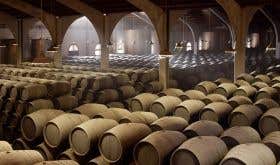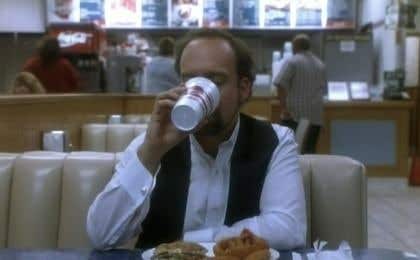‘European Foods Ltd manufacture probably the best tasting cheese alternative in Europe. We can add mature cheddar for a real cheese taste, if you require.’ Yum! I’m sure we can agree that nothing quite excites the old tastebuds like the promise of manufactured cheese alternative.
Yet this cuddly, innocent world of sunbeams and hydrogenated vegetable fats isn’t so carefree as it first appears.
Last year, in a courtroom in the Hague, European Foods’ Magic Cheese product was found to have plagiarised the flavour of Heks’nkaas, a rival cheese spread that both sounds and looks like a sneeze. This was the first case in which flavour was deemed to be copyright-protected, working from a precedent set in 2004 concerning perfume. In that case, Lancôme successfully argued that a knock-off brand had copied the aromatic profile of their Trésor perfume. It’s a verdict that made perfect scents.
Meanwhile, rock legends Led Zeppelin have recently been fighting a high-profile, long-running case in which they were accused of stealing the' Stairway to Heaven' guitar riff from the song 'Taurus' by Spirit. This is just one of many cases where musicians have been accused of unfairly borrowing from each other.
For example, Huey Lewis sued Ray Parker Jr (pictured above right) for ripping off his song 'I Need a New Drug' in the Ghostbusters theme tune and Radiohead had to give a co-writing credit to The Hollies because the former’s 'Creep' bears an uncanny resemblance to the latter’s 'The Air I Breathe'. Perhaps that lesson explains why Radiohead’s song-writing has sounded so utterly unlike anything else ever since.
With a finite number of variables (twelve notes and a handful of conventional chord patterns), many musicians believe that suing has become too easy, because there are bound to be similarities between songs. You might say the same of writing.
But what about wine? That is the question. Whether ’tis nobler in the mind to claim complete originality, or to admit outright that you are imitating something could become a massive issue in wine.
In fact, copyright infringement is already a well-trodden area in the labelling of wine. For instance, LVMH have successfully prosecuted (or threatened to prosecute) several wine producers who have used a similar colour to the one used on their famous Veuve Clicquot ‘yellow label’ brand.
Then there are ‘homages’ such as Timo Mayer’s Yarra Valley Pinot Noir, which blatantly mimics Armand Rousseau’s Chambertin (first reported on by Jancis back in 2009). And just last month, the Francis Ford Coppola winery filed a case against an Oregon producer called Copa for releasing a label that they reckon apes their brand.

Copa copies Coppola?
Let's ignore the fact that Coppola use the term claret on their label apparently without shame. Then, of course, there are countless Chinese rip-offs that brazenly copy existing wine brands to fool consumers with no apparent fear of any consequences. There’s Panfaids or Benfolds instead of Penfolds, Shala One instead of Opus One, not to mention the famous Chinese critics Robert Porker and Huge Johnson, both of whom have a sideline in the adult film industry, I hear.
Okay, I made those last two up. But see this guide to our substantial series on Chinese fakery for no fewer than 16 particularly revealing reports.
The most worrying potential for wine concerns flavour, however. If one type of cheese can be prosecuted for tasting too much like another type of cheese, then what must the implications be for Veneto Pinot Grigios or Alsace Gewurztraminers – or indeed any wine?
Chardonnay provides many pertinent examples. Famously malleable, it is something of a blank canvas upon which producers can imprint their signature terroir or winemaking (or both). Hence a village Chablis tastes very different from a Hunter Valley Chardonnay, which is different again from Blanc de Blancs champagne.
So distinctive are some of these styles, that the most famous proponents get namechecked in tasting notes: Coche-Dury-esque for those Chardonnays which have a strong reductive quality, for example. So is that famous Burgundy domaine within its rights to sue any other Chardonnay producer making a similar-tasting wine?

One American producer volunteers itself as the ideal test case. Replica make seven single-varietal wines from California and Oregon fruit, and are soon expanding to the Veneto. They explicitly blend each cuvée to mimic an existing brand: ‘using our proprietary patent-pending technology, we identify key flavor characteristics of your favorite wines and create near-identical knockoffs'.
Indeed, their Knockoff Chardonnay is modelled on Kendall Jackson Vintners Reserve Chardonnay, a gustatory proposition which I would rank alongside manufactured cheese alternative, while Label Envy is a Sonoma Coast Pinot Noir that rips off La Crema.
Replica’s business model might seem outrageous, but at least they are using grapes as their raw material. At Ava Winery, they are aiming to engineer a synthetic recreation of wine using water, acids and alcohol and flavour chemicals. Their first target is Dom Pérignon 1992 – hardly a modest start.
Surely Dom Pérignon’s owners LVMH have their lawyers on standby. After all, this is the company that sues people for using the wrong shade of yellow. The rest of us will have to wait and see what happens.













